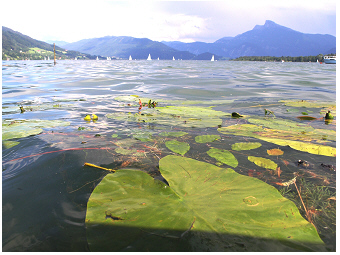About lake Mondsee: The most well-studied deep alpine lake in the Salzkammergut district
geographical location of the lake in the austrian alps
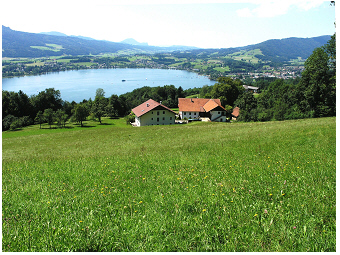 Alpine lake Mondsee, 2010:
Alpine lake Mondsee, 2010:
The lake is surrounded by four
municipalities: the north bay shown here is close to Mondsee (town,
downhill) and
Tiefgraben (mainly farmyards, uphill). The further two
municipalities are
Innerschwand and St. Lorenz.
Lake Mondsee is an alpine lake in the
Salzkammergut
district
in Upper Austria,
about 30 kilometers away from the city of Salzburg.
Its location (47°49’41.88''N,
13°22’46.56''E)
is at 481 m above sea level with an area of 14.21 km2
and volume of 510 x 106 m3.
The lake has an elongated shape,
which extends over a
distance of about 10 km from the town
Mondsee, at the northwest
shore, to the southeast outflow of the lake. The northern part, close
to the rocky face ‘Drachenwand’, is the deep part of the lake with a
maximum depth of 68 m,
while the southeast end forms a shallow bay. The
theoretical The theoretical water
retention time of lake Mondsee is 1.7 years (Table
1 in Dokulil et al.
2006 R).
The lake
is largely surrounded by meadows, some forested areas and has even a
partly rocky shoreline. Single farmyards, small villages and, as
mentioned before, the town Mondsee further join the shoreline of the
lake. Despite the narrowness of the road even lorries pass through.
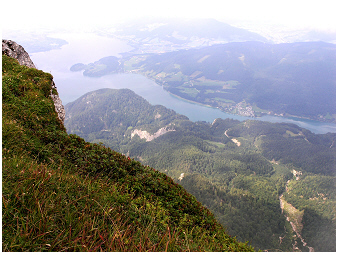 Alpine lake Mondsee, 2005:
Alpine lake Mondsee, 2005:
The elongated shape of the lake can be seen from the viewpoint
of the 'Schafberg' Mountain. Different
from road traffic, motor craft are successfully
kept
away on
the lake. Tourists may enjoy the silent place of the lake even during
busy summer holiday time. Typically, a view onto the lake in summer
shows plenty of sailing boats. Only a few motorboats for business
reasons are allowed on the lake. Sustainable livestock farming in the
catchment of lake Mondsee
is described on the site about lake Attersee
S,
together with the catchment of other alpine lakes in the Salzkammergut
district.
Among all the lakes of
the
Salzkammergut district, Mondsee is
the most well studied lake. Temperature and main nutrient
concentrations were recorded from depth profiles or surface water since
the late sixties, for more than 40 years. Further, the abundance and
biomass of some photosynthetic microbes, as algae and cyanobacteria in
the surface water, were, for example, also studied over four to six decades in
Mondsee (Dokulil & Teubner 2012 R, 2023 R).
The following ecological description focuses on the primary
producers of the lake, mainly on the photosynthetic
microorganisms in
the water body but also to some extent on aquatic plants. Information
about other studies of lake Mondsee, from bacteria to fish, is provided
at websites of the
Research Institute of Limnology
(located in Mondsee) and the
Federal Agency for Water Management focussing among
other topics on freshwater
ecology and fisheries (Bundesamt für Wasserwirtschaft, located in Scharfling).
a lake turns up side down:
the
importance of deep living Planktothrix
rubescens in mondsee
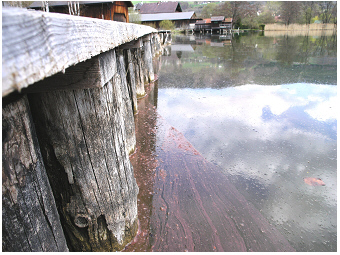 Planktothrix
rubescens in deep alpine lake Mondsee, north-west shore,
2004:
Planktothrix
rubescens in deep alpine lake Mondsee, north-west shore,
2004:
The outburst of metalimnetic Planktothrix
rubescens is seen best on a calm day, building a
bordeaux-red coloured surface
scum. Such scum is not typically found in Mondsee but
may occurre occasionally few days to weeks in summer-time.
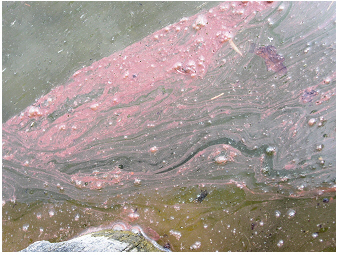 Planktothrix
rubescens in deep alpine lake Mondsee, 2004:
Planktothrix
rubescens in deep alpine lake Mondsee, 2004:
as the left photo but detailed view (see details about the
long-term development of Planktothrix
rubescens in Mondsee driven by phosphorus availability
and climate change (Dokulil & Teubner 2012 R, 2023 R)
).
High concentrations of nutrients from sewage effluents were accumulated in lake Mondsee from 1969 to 1984. During this period, the peak concentration of the nutrient element phosphorus calculated as an annual mean of total phosphorus of a water sample was 35 µg L-1 in 1978 (1.13 µmol L-1, results at p.32 in Dokulil & Teubner 2012 R; further Dokulil & Teubner 2005 R). In many lakes nutrient enrichment is stimulating the growth of photosynthetic microorganisms near the water surface. The community of such primary producer organisms that is floating in the water is called phytoplankton and relates to various algae and cyanobacteria in a lake. These microorganisms contain green pigments as chlorophylls and other photosynthetic pigments and accordingly the watercolour changes to green. Not so far for lake Mondsee, at least in the period of remarkable nutrient input, the watercolour changed to bordeaux-red (Greisberger & Teubner 2007 R, Dokulil & Teubner 2012 R). The reason was the predominant development of the red coloured photosynthetic microorganism, the cyanobacterium Planktothrix rubescens, which were at that time the dominant form among other algae and cyanobacteria in summer in Mondsee. The absorption properties of a specific photosynthetic pigment, the red coloured phycoerythrin, allow this organism to survive even at deeper strata of 9-12 m (Dokulil & Teubner 2000 R, Fig.6 in Greisberger & Teubner 2007 R, Figs.3-4 in Dokulil & Teubner 2012 R). At this depth dim light only is available for photosynthesis. These low-light intensities relate to about 0.1-1% of light intensity penetrating from the surface through the water column. The biomass of Planktothrix rubescens ,however, is often estimated by another specific pigment occurring in Planktothrix and only a few other organisms. This marker pigment is oscillaxanthin (Table 2 in Greisberger & Teubner 2007 R, Fig.7 in Dokulil & Teubner 2012 R).
For a period lasting even over years,
Planktothrix rubescens may build up their main biomass
in deeper depths, while closer to the surface this cyanobacterium is
absolutely rarely found by observing samples under a microscope. For
example, in July 2002, the biovolume of this red coloured
cyanobacterial plankton organism was at 12.5 to 14.5 m depth about 1
mm3 L-1 while less than
0.1 mm3L-1 was measured
in the surface layer.
Other photosynthetic organisms contribute a biovolume of 0.14 mm3L-1
in deep strata (mainly algae as Cryptomonas,
Rhodomonas, some
diatoms) and 0.06 mm3L-1
in the surface layer only. In this case Planktothrix
rubescens is
dominating the lake phytoplankton composition, and hence this
cyanobacterium is the main contributor to phytoplankton productivity of
the lake. In lakes usually the majority of photosynthetic plankton
occurs in the surface layer due to the availability of sufficient light
for photosynthesis. In Planktothrix-lakes,
however, the water body seems turned upside down as the phytoplankton
life is focused not at surface but at the deep layer (see also
Ammersee, Teubner et al.
2007 R).
This lake
phenomenon is called to build up a deep chlorophyll maximum.
Chlorophyll-a is here used as a rough estimator for phytoplankton
biomass, as all photosynthetic plankton organisms from eukaryotic algae
to prokaryotic photosynthetic (cyano)bacteria have in common the
photosynthetic pigment chlorophyll-a among other more specific pigments
in their photosynthetic apparatus. Living in the deep layer, Planktothrix rubescens can
undergo a remarkable development over periods of eutrophication not
visible in the
surface water. A trend of increasing
biomass of Planktothrix rubescens
can be
easily overlooked unless samples are collected with
extreme care and
attention from deeper layers in Mondsee
(Teubner et al. 2022 R),
see also discussion about useful sampling intervals on the website about
Bergknappweiher S).
An
outburst of this deep
living cyanobacterium even in the surface layer may also occur from
time to time. At least in years of heavy biovolume development, as was
common during the nutrient-rich summer periods in the seventies, the
shoreline of lake Mondsee was coloured bordeaux-red. The peak biovolume
of Planktothrix of
4.5 mm3L-1 for a
depth-integrated sample was
recorded in summer 1978.
The biovolume for a separate deep-water sample was even higher at that
time. Holidaymakers avoided going swimming in lake Mondsee at that
time. After construction of a sewage drain system (‘Ringkanalysation’)
in the 70ies to 80ies, which carries sewage from housing around the
lake to sewage treatment facilities, the water quality of lake Mondsee
has been improved. The trophic state of Lake Mondsee in recent years is
described as oligo- to mesotrophic. This means that the lake ecosystem
was largely recovered from nutrient rich conditions and that water
quality is now close to the reference status of an alpine lake (see
reference conditions described by ultra-oligotrophic status of the
alpine lake
Attersee S).
the transparency of water:
what does it mean for photosynthetic microorganisms in
Mondsee
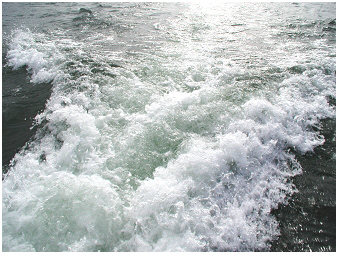 Alpine lake Mondsee, 2002:
Alpine lake Mondsee, 2002:
Crystal clear water at the deepest site.
Deep living Planktothrix
rubescens is an exception to the rule of planktonic
primary producers in a lake
(Teubner et al. 2022 R). Different from Planktothrix
rubescens most photosynthetic organisms need much higher
light intensities than dim light for photosynthesis. Hence the primary producers are
growing in the surface layer in lake Mondsee. This lake surface layer
inhabiting commonly photosynthetic organisms extends from the top 100%
light intensity to deeper strata where at least 1% of surface light
intensity is penetrating. This surface layer is called the euphotic
zone. Phytoplankton organisms, however, are not necessary evenly
distributed in the euphotic zone along the vertical profile. The near-surface maximum of phytoplankton
biomass most days a year or at least on calm days without
mixing by wind, is found at the shallow depth with 11-12% of surface
light intensity. Such light intensities are typically found at
2-5m water depth
in an alpine lake like Mondsee. At the very near surface, at 0-0.5m,
usually not that many phytoplankton organisms are occurring in Mondsee
as stress of high light intensity and UV radiation are inhibiting
photosynthesis and hence reduce phytoplankton growth rates on the top
surface of the lake.
The depth of the euphotic zone (euphotic depth) may vary among seasons and years (Teubner I., 2005 R). According to measurements of underwater light climate, the euphotic depth was on average at 11.3m in 1999 and at 11.1m in 2000 for lake Mondsee. In the case of only a few floating organisms, as in winter or in years of low nutrient concentrations, light is less absorbed or scattered by particles and can hence penetrate into deeper strata than at higher particle densities as in summer or nutrient-rich years. For practical reasons, the euphotic depth is usually not directly measured by a light sensor but is visually estimated by Secchi disc transparency (Secchi depth). Absorption and scattering properties by living particles containing even pigments are distinct from those of non-living particles and hence the conversion factor between both methods change with the season. During the growing season, when water transparency is mainly reduced due to living algal particles, i.e. from May to September, the Secchi depth might be multiplied by the factor 3.42 to calculate the euphotic depth in Mondsee. For the remaining period each year, from October to April, the Secchi depth multiplied by 1.8 is a good proxy to estimate the euphotic depth in this alpine lake (the factors relate to monthly to biweekly measurements by both methods in lake Mondsee for 2000-2001). Light, or better to say the (photosynthetically active radiation of wavelength from 400 to 700 nm (PAR), is utilised via photosynthesis by primary producers as aquatic plants, algae and photosynthetic bacteria. The number of pigments that are associated with photosynthesis found in a water sample, for example, depends largely on the diversity of composition of phytoplankton. Some pigments are ubiquitous as they are common in all or many algal classes, others are occurring in only a few algae. In lake Mondsee, exemplified for the period 2000-2001, about 60 phytoplankton genera were found by microscopy (the number of species is even higher as in many cases several species of very similar pigment composition are assigned to one genus). This phytoplankton composition relates to a variety of abundant pigments as four chlorophylls, three phycobiliproteins and 23 carotenoids (Greisberger & Teubner 2007 R). All these pigments were analysed by acetone extraction and chromatography; and were found in at least 20% of the phytoplankton samples taken in 2000-2001 (the number of analysed samples is 584). The chlorophylls, phycobilines (e.g. phycoerythrin in Planktothrix rubescens see above) and a few carotenoids are involved in light harvesting of photosynthesis. Most of the carotenoids, however, have the function to protect the photosynthetic apparatus against too high intensities of light (PAR) and ultraviolet radiation (UV). Shifts in the proportion between light-harvesting and light-protective pigments enable phytoplankton organisms to cope well with the varying weather situation, as they adjust rapidly to low and high light intensities on a clouded or sunny day (Teubner et al. 2001 R). Other species are in general adapted to a specific light intensity range and are found typically in winter-spring or in summer-autumn. Such species are described as common taxa for a specific seasonal period.
In addition to the adjustment to light by changing pigment composition, many phytoplankton organisms are able to move to a certain water depth layer that provides ‘optimal’ light intensities for their physiology. This phenomenon has been mentioned before, saying that the near-surface maximum biomass of phytoplankton is usually found at a depth of 11-12% of surface light intensity in Mondsee. Some algae and in particular, photosynthetic cyanobacteria (e.g. Planktothrix rubescens is most abundant at a depth of 0.1-1% of light intensity, see above) are known to move vertically by buoyancy regulation. Many algae even can swim, e.g. by using flagella. On a calm day, these algae are able to move from centimetres to metres along the vertical water column within some minutes. Some of the flagellated forms even move regularly during day and night. Such pronounced diurnal migration was e.g. recorded for algae as Ceratium and some Cryptomonas species in Mondsee July 2000 and describes a common summer situation for some flagellated phytoplankton species living in deep lakes. A very detailed taxonomic analysis of phytoplankton in the alpine mesotrophic lake Ammersee has shown, that a considerable number of phytoplankton taxa, namely 40% of a total number of 83 phytoplankton taxa, belong to flagellated forms (Teubner et al. 2003 R). Even if not analysed in detail, the number of flagellates might also hold for Mondsee as both lakes are of similar trophic status and phytoplankton composition. The key species of the aquatic food webs in Mondsee and other deep temperate lakes are in detail decribed in Qu et al. 2021 R.
annual cycles by heating and cooling of
the water body
affect the
growth of photosynthetic
microorganisms in mondsee
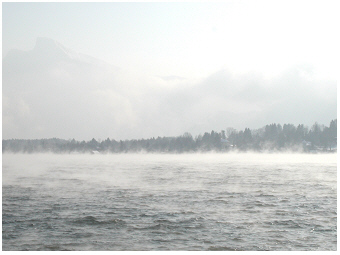 Alpine lake Mondsee,
December 2001:
Alpine lake Mondsee,
December 2001:
Heat loss by surface cooling - lake fog covers the lake in late autumn
to early winter.
In addition to the primarily effect of light on
photosynthesis, sunshine can also affect growth of primary producers
via temperature change by heating or cooling the water body. In
Mondsee, the annual minimum of light and temperature occurs in winter,
the maximum in summer, as given by a temperate climate zone. With
increasing sunshine duration from winter to summer the temperature
increases, air and water successively warm up. The summer peak of air
temperature lags 28 days behind the annual peak of total incoming
radiation. It needs, however, considerably longer to warm up the water
to its summer maximum. The time lag between the annual peak of total
incoming radiation and surface water temperature is 37 days, the
thermal stability of the water column calculated as Schmidt stability
is 46 days and the heat content of the whole water body of lake Mondsee
is 53 days, respectively. In other words, the summer peaks are passing
successively, on average on 24.July for air temperature (on Julian day
205, i.e. the 205th day in the year), on 5.August for water surface
temperature (Julian day 217), on 12.August for thermal stability of the
water column (Julian day 224) and on 20.August for the heat content of
the whole water body of Mondsee (Julian day 232), respectively. From
those days onward in the year, the air and water are becoming cooler.
Heat loss by surface cooling due to evaporation can be seen on a calm
day in winter, when lake fog covers Mondsee. The seasonal development
of phytoplankton measured by chlorophyll-a - the pigment that is common
in all these planktonic primary producers - shows twice a year
pronounced phytoplankton biomass peaks. The main phytoplankton peak
appears on average in spring on 25.April (Julian day 115), the second
peak is in autumn on 11.October (Julian day 284), respectively. The
timing of these two phytoplankton peaks is not by chance but relates to
growth periods of sufficient nutrient and light availability during the
two mixing periods,
namely in spring after ice-cover and winter stagnation and in autumn
after summer stratification (spring turnover and autumn turnover). The
complete circulation from surface water to the bottom layer at sediment
two times a year, in other words, the twice mixing of the whole water
body even at the deepest site of 68m, characterize Mondsee as a dimictic lake. Still in
ice-free winters, the lake Mondsee the bottom temperature is higher
than the water surface relating to inverse stratification. Hence the
lake has tended to maintain a dimictic mixing regime even in years with
mild winters, at least for the observation period from 1978 to 2004.
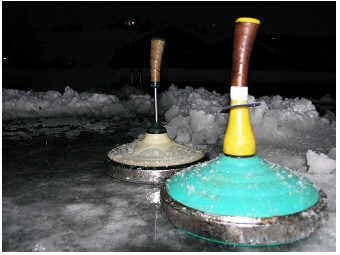 Alpine lake Mondsee, March
2005:
Alpine lake Mondsee, March
2005:
The frozen lake - ice stock
sport is popular on ice in winter
('Eisstockschiessen').
The period between spring and autumn, which
relates mainly
to
the growing season
in the field, is characterized by thermal
summer stratification in the lake. This stratification
subdivides horizontally the water body in three layers. The top water
layer is heated up by solar radiation. This warmed up surface layer of
low density, the epilimnetic layer (epilimnion),
stratifies on top of cool and hence denser water of deeper strata, the
hypolimnetic layer (hypolimnion).
In early summer, the epilimnion is very shallow but extends with time
during a calm weather situation. The temperature difference between
epilimnetic and hypolimnetic layer increases and culminates in a
maximum difference in early August in lake Mondsee. On 12.August
(Julian day 224), the day of annually peaking water column stability,
for example, the temperature is 20.13°C for the epilimnion of the top
6m and 5.07°C for hypolimnion from 30-68m in Mondsee (Julian day and
temperature calculated as 26-year-average for Mondsee period
1978-2003). While the epilimnion is turbulent and hence plankton
organisms are circulating by vertical mixing within this layer, the
hypolimnion is rather stagnant. The third layer during thermal
stratification, namely that located between epi- and hypolimnion, is
the metalimnetic layer (metalimnion)
and extends during stable stratification for some metres. This layer is
characterized by an enhanced density gradient that creates a strong
buoyancy force suppressing vertical motion and hence avoids entrainment
of particles e.g. filaments of deep living Planktothrix
rubescens as mentioned above. Within the metalimnion the
thermocline can be defined as narrow depth, identified by the maximum
value of relative thermal resistance against mixing, and relates to the
mixing depth. In Mondsee, the euphotic
depth usually exceeds the mixing depth throughout the period of thermal
stratification in summer. The euphotic depth of 1% of
surface light intensity was exemplified for 1999 and 2000 above. During
thermal stratification in summer 1999 and 2000, the euphotic zone
exceeds the mixing zone on average by about 1.4m, which relates to the
ratio of mixing zone to euphotic zone of 0.9 during thermal
stratification. In other words, phytoplankton organisms, which are
circulated by vertical mixing in the epilimnion, move within the
euphotic zone, i.e. move within a zone of sufficient light for
photosynthesis. Nevertheless, other factors than light may limit the
growth of phytoplankton. Nutrient limitation of phytoplankton growth
occurs at various periods in lake Mondsee, not outlined in detail here.
It is noteworthy that phytoplankton living at the epilimnion, or even
some species in the metalimnion, undergo a growth of nutrient
limitation during thermal summer stratification. This is as the
metalimnion acts as the barrier where nutrient elements released from
sediment cannot freely pass to the upper layer. Hence the replenishment of nutrients
goes much more slowly than rapidly demanded by epilimnetic
phytoplankton growth. During stratification, epilimnetic phytoplankton
growth is reliant on small portions of fast re-cycled, exudated or
excreted phosphorus by other organisms in the nearby environment.
Sufficient nutrients are replenished in the epilimnion by autumn and
spring turnover as nutrient rich hypolimnetic water is circulated to
the surface layer of the lake (hypolimnetic nutrient enrichment is due
to release of nutrients from the sediment during stratification). In
this view, solar ration ‘controls’ the growth of primary producers not
only via the light-photosynthesis relationship but also via seasonal
temperature dynamics.
the response to climate change in lake Mondsee
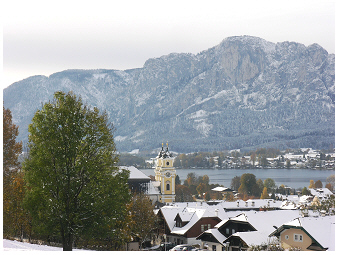 The alpine lake Mondsee
with town Mondsee
on
the north bay, 2012:
The alpine lake Mondsee
with town Mondsee
on
the north bay, 2012:
Early snow in autumn.
The yield of phytoplankton biomass is often discussed by
its
relationship to nutrient concentrations in a lake. A questioner is
typically asking for quantities, as e.g. ‘How much phytoplankton
biomass is built in spring in Mondsee?’ A different view comes up with
questions starting with the word when: When is the spring peak of
phytoplankton biomass achieved in Mondsee? Asking for the timing of
particular events or the duration of periods is close to climate lake
research, the lake phenology.
‘Global’ climate acts through ‘local’ weather in the Salzkammergut
district. The geographically most relevant climate signal
for lake
Mondsee is the North Atlantic Oscillation index (Dokulil et al.
2006 R,
Blenckner et al.
2007 R,
Dokulil et al.
2010 R)
. This index relates to
the atmospheric pressure differences between Iceland and the Azores and
shows positive and negative anomalies, as the values for certain months
or seasons or years are above or below the respective long-term
average. For Mondsee, the weather conditions are significantly linked
to this large-scale climate index. In years when the NAO value is above
the long-term NAO average, the so-called NAO-positive years or years
with positive NAO signal, the ‘local’ weather situation is described by
high solar radiation, high air temperature and low precipitation in the
Salzkammergut district. In turn, NAO negative years refer mainly to
cold and rainy years in the Mondsee region. As the climate signal is
closely linked to solar radiation and temperature currencies, not
surprisingly, the climate effects on the lake are primarily seen by
changes in lake physics. Alterations of lake physical conditions, as
e.g. the timing of ice-off or the duration of thermal summer
stratification might affect further other compartments as e.g. the
timing of nutrient availability for phytoplankton growth or the timing
of grazer offspring (zooplankton). In this way, the changing climate
conditions have been cascading effects through the ecosystem, from
physics to chemical or even biological features in Mondsee. The effects
of climate signal, however, become weaker the less general rules of
lake physics, and the more individual circumstances of lake biology are
concerned. The temporal coherence among lakes in the Salzkammergut
district is for physical parameters, as the seasonal development of
water temperature, much closer than for lake chemistry and sometimes
even lost on the side of the lake biology (Fig.1
in
Dokulil & Teubner
2002 R,
Fig.3 in
Blenckner et al.
2007 R,
Fig.6
in
Dokulil et al.
2010 R)
.
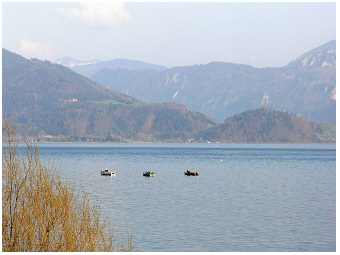 Alpine lake Mondsee, 2006:
Alpine lake Mondsee, 2006:
Fisherman boats in
spring - the response to global warming is best seen by time shifts
early in the
year.
The climate phenomenon of global warming
in recent decades is often discussed for
ecosystems worldwide, including alpine lakes from Austria in such large data set
(O’Reilly CM et al., 2015 R,
Sharma et al., 2015 R,
Woolway et al., 2015 R)
A coherent trend of increasing deep-water temperature of
about 0.1 to 0.2 degree Celsius per decade was found for
lake Mondsee
and other lakes across Europe (hypolimnetic water temperature, Fig.2
& Table 2 in
Dokulil et al.
2006 R).
The response to global warming is usually best seen early
in the year, in spring. The example here relates again to thermal
stratification in summer as described before. The time series of the
onset of stratification of recent decades is depicted by the Julian day
each year, when a critical threshold value of thermal resistance
against mixing is passed over. In other words, it is the date each year
when a larger extent of surface layer is heated enough by solar
radiation that thermal stratification holds on against vertical mixing
by epilimnetic turbulence even induced by moderate wind. This onset of
thermal stratification varied from year to year in lake Mondsee in the
past decades. Extreme early stratification was found on 19.April-2.May
in warm years (Julian day 109-122), i.e. in NOA-positive years (Fig.10
in
Dokulil et al.
2010 R).
In cold
years, i.e. in NAO negative years, the on-set was about one month
delayed, occurring around 20.-28.May (Julian day 140-148). In moderate
years, not too warm and not too cold, the on-set of thermal
stratification usually was passed from early to mid May. The off-set of
thermal stratification differed also from year to year in lake Mondsee,
depending on a warm or cold year, but dates were less fluctuating with
time than the on-set.
The change with time, as climate change, is seen by temporal trends. In recent decades, exemplified here for the period 1982-2003, the on-set of stratification became progressively much earlier in the year(Fig.10 in Dokulil et al. 2010 R), the off-set slightly later. In other words, today spring events in lake Mondsee, have the tendency to pass usually earlier than about 20 years ago. The time-span between onset and offset of thermal stratification is the measure for the duration of thermal stratification. This time-span, the duration of ‘lake summer’ in Mondsee, became also progressively longer, namely 6.5 days per decade. Such temporal trends were responded to by biological trends, as the spring peak of phytoplankton today also tends to appear earlier in the year (Fig.8 in Dokulil et al. 2010 R). Warming, however, might not be necessarily beneficial for photosynthetic microorganisms. Planktothrix rubescens provides an example of a microorganism to benefit from climate warming early in the year only, namely during late spring overturn and early summer. Longer periods of summer stratification did not favour biovolume development of this cyanobacterium in lake Mondsee (Figs.9&10 in Dokulil & Teubner 2012 R).
the macrophytes of lake Mondsee:
a tender green belt covers the narrow shore area
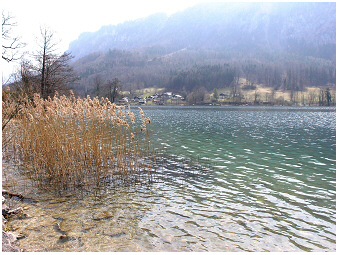 Alpine lake Mondsee, 2012:
Alpine lake Mondsee, 2012:
Limited littoral stands of Phragmites
australis -
spotwise littoral reed islands are the relict of former reed belts due
to commercial misuse of the land-water interface over recent decades.
The more weak the reed belts, the more
vulnerable becomes a lake; the less intact the land-water interface is,
the weaker the lake ecosystem capacity to guarantee a good
water-quality.
Aquatic plants, called macrophytes, grow well
on a wetland
close to the shoreline or under-water (littoral) until at water-depth
where sufficient light is still available for plant growth. The
morphology of the water basin of deep alpine lake Mondsee refers to
steep shores and hence, the shallow zone of the shore, the littoral zone of the
lake, is narrow for macrophyte stands living in the water. In addition,
a coarse grained sometimes even rocky underground at the bottom in the
littoral zone, is not beneficial for macrophyte rooting and sprouting.
Expanded macrophyte stands cannot be expected in lake Mondsee as found,
for example, from riverine shallow lakes in North Europe or from mouths
of large rivers as e.g. the Danube delta (see on this website
Danube S).
Nevertheless,
some
macrophytes inhabit naturally the lake Mondsee. The macrophyte Phragmites australis for
example, reed, occurs in lake Mondsee. This species is common in the
world. Littoral reed belts
are known to contribute to
ecosystem health in many ways. They provide microhabitats
for attached living algae (benthic algae, here mainly diatoms), which
compete well for phosphorus and hence can be seen to control to some
extent the growth of other algae as phytoplankton species. Further,
non-living particles such as, for example, dead cells of phytoplankton,
are settling in littoral reed stands. This organic material mineralised
by microorganisms is fertilizing the sprouts of Phragmites.
Underground
rhizomes of Phragmites
are known to contribute to an aeration of sediment. And it shouldn’t be
forgotten that littoral reed belts serve as valuable habitats for many
animals as molluscs, crustaceans, insects, fish and water birds.
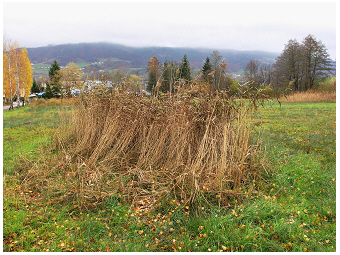 Alpine lake Mondsee, 2012:
Alpine lake Mondsee, 2012:
The only wet meadow remained at the north-west
shore - land stands of Phragmites
australis appear as isolated islands.
Most area of a former large wet meadow area in the north-west of the
lake has been replaced by new roads, housing and shopping areas the
recent 25 years.
In general, Phragmites
can grow on both habitats, near and in the water and is therefore, a
dominant land-water ecotone species in the world. Phragmites
spreads from the
land into the lake as underground rhizomes grow horizontally from the
wetland into the littoral zone of a lake. Sprouts from land stands
hence can continuously re-generate reed stands in the lake. In case the
land-habitat of Phragmites
is destroyed, e.g. by changed
land-use, sprouts in the littoral zone of the lake cannot
be generated by wetland stands. Hence it is often just a question of
time before remaining stands in the littoral zone also disappear.
Land-water ecotones of lake Mondsee, became more and more rare in the
recent 30 years. Limited littoral reed belts are still occurring in the
north-west shore. Wetland and meadows on this shore, however, were
drained and have now been replaced
by housing and shopping areas in the last decade. Meadows
on the west-shore also act not as refuge for land stands of Phragmites. Here, at the
shallow littoral zone in Mondsee, which might be covered by Phragmites, reed is in some
years partly replaced by filamentous
green algae competing well for phosphorus among plants.
Some reed occurs in the shallow south bay of Mondsee. Even here, Phragmites appears spot wise
only, built rather littoral
reed islands than littoral reed belts. Due to the road
narrow the shoreline of lake Mondsee, the connectivity between wetland
or meadows and littoral zone of the lake is almost completely lost.
Phragmites cannot pass the road and hence regeneration of littoral Phragmites stands by land
stands is today much more rarely found than a decade ago.
Other macrophytes, as e.g. submerged Nuphar and Potamogeton also occur in lake Mondsee and built littoral stands between reed belt and the open water of Mondsee.
cited References: about mondsee
Dokulil M, Teubner K (2024) Long-term adjustment of phytoplankton structure to environmental traits at timescales during lifetime development and over generations. Hydrobiologia,851:823-847. DOI:10.1007/s10750-023-05365-6 OpenAcess
Teubner K, Dokulil MT, Kurmayer R (2022) Eutrophierung, toxische Cyanobakterien am Beispiel des urbanen Donau-Altarmgewässers Alte Donau und des alpinen Mondsees. In: Mikrobiologie und Wasser. Teil 2: Fallstudien zur Illustration der neuen diagnostisch-analytischen Möglichkeiten. Farnleitner AH, Kirschner AKT, Frick C, Proksch P and Vogl W (eds.), Arbeitsbehelfe Österreichischer Wasser- und Abfallwirtschaftsverband (ÖWAV), Wien, 52(2):35–45 FurtherLink Look-Inside
Qu Z, Forster D, Bruni EP, Frantal D, Kammerlander B, Nachbaur L, Pitsch G, Posch T, Pröschold T, Teubner K, Sonntag B, Stoeck T (2021) Aquatic food webs in deep temperate lakes: key species establish through their autecological versatility. Molecular Ecology,30:1053-1071 DOI:10.1111/mec.15776 OpenAccess
Woolway RI, Cinque K, de Eyto E, DeGasperi CL, Dokulil MT, Korhonen J, Maberly SC, Marszelewski W, May L, Merchant CJ, Paterson AM, Riffler M, Rimmer A, Rusak JA, Schladow SG, Schmid M, Teubner K, Verburg P, Vigneswaran B, Watanabe S, Weyhenmeyer GA (2016) Lake surface temperatures. In: State of the Climate in 2015 (Eds. Blunden J, Arndt DS), Bulletin of the American Meteorological Society, 97(8):S17–S18 FurtherLink / FurtherLink
O’Reilly CM, Sharma S, Gray DK, Hampton SE, Read JS, Rowley RJ, Schneider P, Lenters JD, ..., Teubner K, ... (2015) Rapid and highly variable warming of lake surface waters around the globe. Geophysical Research Letters, 42:1–9 DOI:10.1002/2015GL066235 OpenAccess Global Lake Temperature Collaboration / GLTC_history, by Lenters
Sharma S, Gray DK, Read JS, O’Reilly CM, Schneider P, Qudrat A, Gries C, Stefanoff S, Hampton SE, Hook S, Lenters JD, Livingstone DM, ..., Teubner K, ... (2015) A global database of lake surface temperatures collected by in situ and satellite methods from 1985–2009. Scientific Data, 2:150008 DOI:10.1038/sdata.2015.8 OpenAccess Blog_GLTC-group /Blog_GLTC-Sci_Data
Dokulil M, Teubner K (2012) Deep living Planktothrix rubescens modulated by environmental constraints and climate forcing. Hydrobiologia, 698:29–46 DOI:10.1007/s10750-012-1020-5 OpenAccess
Dokulil, M., Teubner, K., Jagsch, A., Nickus, U., Adrian, R., Straile, D., Jankowski, T., Herzig, A. & J. Padisįk 2010. The impact of climate change on lakes in Central Europe. In: The Impact of Climate Change on European Lakes (Ed. DG George), Aquatic Ecology Series (Ed. J. Huisman), Springer Publisher, 387-410. doi: 10.1007/978-90-481-2945-4_20 Abstract FurtherLink
Nõges, P., Anneville, O., Arvola, L., Blenckner, T., George, D.G., Jankowski, T., Järvinen, M., Maberly, S.C., Padisįk, J., Straile, D., Teubner, K. & G. Weyhenmeyer. 2010. The impact of variations in the climate on seasonal dynamics of phytoplankton. In: The Impact of Climate Change on European Lakes (Ed. DG George), Aquatic Ecology Series (Ed. J. Huisman), Springer Publisher, 253-276. doi:10.1007/978-90-481-2945-4_14 Abstract FurtherLink
Greisberger, S., Dokulil, M. & K. Teubner. 2008. A comparison of phytoplankton size-fractions in Mondsee, an alpine lake in Austria: distribution, pigment composition and primary production rates. Aquatic Ecology, 42, 379-89. doi:10.1007/s10452-007-9095-1 Abstract FurtherLink
Greisberger, S. & K. Teubner. 2007. Does pigment composition reflect phytoplankton community structure in differing temperature and light conditions in a deep alpine lake? An approach using HPLC and delayed fluorescence (DF) techniques. J Phycol, 43, 1108-19. doi:10.1111/j.1529-8817.2007.00404.x Look-Inside FurtherLink
Blenckner, T., Adrian, R., Livingstone, D.M., Jennings, E., G. A. Weyhenmeyer, Aonghusa, C. N., George, D. G., Jankowski, T., Järvinen, M., Nõges, T., Straile, D. &. K. Teubner. 2007. Large-scale climatic signatures in lakes across Europe: a meta-analysis. Global Change Biology, 13: 1314-26. Abstract FurtherLink
Kaiblinger, K., Greisberger, S., Teubner, K. &. M. Dokulil. 2007. Photosynthetic efficiency as a function of thermal stratification and phytoplankton size structure in an oligotrophic alpine lake. Hydrobiologia, 578: 29-36. doi:10.1007/s10750-006-0430-7 Abstract FurtherLink
Dokulil, M. T., Jagsch, A., George, G. D., Anneville, O., Jankowski, T., Wahl, B., Lenhart, B., Blenckner T. & K. Teubner. 2006. Twenty years of spatially coherent deep-water warming in lakes across Europe related to North-Atlantic Oscillation. Limnol Oceanogr, 51 (6): 2787-93. doi:10.4319/lo.2006.51.6.2787 OpenAccess
Dokulil MT, Teubner K (2005) Do phytoplankton assemblages correctly track trophic changes? – An assessment using directly measured and palaeolimnological data. Freshwater Biology, 50 (10):1594–1604 DOI:10.1111/j.1365-2427.2005.01431.x Look-Inside FurtherLink
Teubner, I. 2005. Anwendung mathematischer Funktionen auf biologische Abläufe in Hinblick auf die Gewässerökologie. Fachbereichsarbeit in Mathematik und Biologie, Christian Doppler Gymnasium - BRG II Salzburg, Mondsee: 35 pages. FurtherLink
Teubner, K., Tolotti, M., Greisberger, S., Morscheid, H., Dokulil, M.T. & H. Morscheid. 2003. Steady state phytoplankton in a deep pre-alpine lake: Species and pigments of epilimnetic versus metalimetic assemblages. Hydrobiologia 502: 49-64. Look-Inside FurtherLink
Dokulil, M.T. & K. Teubner. 2003. Steady state phytoplankton assemblages during thermal stratification in deep alpine lakes. Do they occur? Hydrobiologia, 502: 65-72. Abstract FurtherLink
Crosbie, N.D., Teubner, K. & T. Weisse. 2003. Flow-cytometric mapping provides novel insights into the seasonal and vertical distributions of freshwater autotrophic picoplankton. Aquat Microb Ecol 33: 53-66. Abstract OpenAccess
Dokulil, M.T. & K. Teubner. 2002. The spatial coherence of alpine lakes. Verhandlungen der Internationalen Vereinigung für Theoretische und Angewandte Limnologie (Verh. Internat. Verein. Limnol.) 28, 1-4. Look-Inside
Teubner, K. 2001. Algengemeinschaften in Seen. 83-112. In: Ökologie und Schutz von Seen. UTB Facultas, Wien. Look-Inside
Teubner, K., Sarobe, A., Vadrucci, M.R. & M. Dokulil. 2001. 14C photosynthesis and pigment pattern of phytoplankton as size related adaptation strategies in alpine lakes. Aquat Sci 63: 310-25. doi:10.1007/PL00001357 Look-Inside FurtherLink
Dokulil, M. & K. Teubner. 2000. Cyanobacterial dominance in lakes. Hydrobiologia 438: 1-12. Abstract FurtherLink
